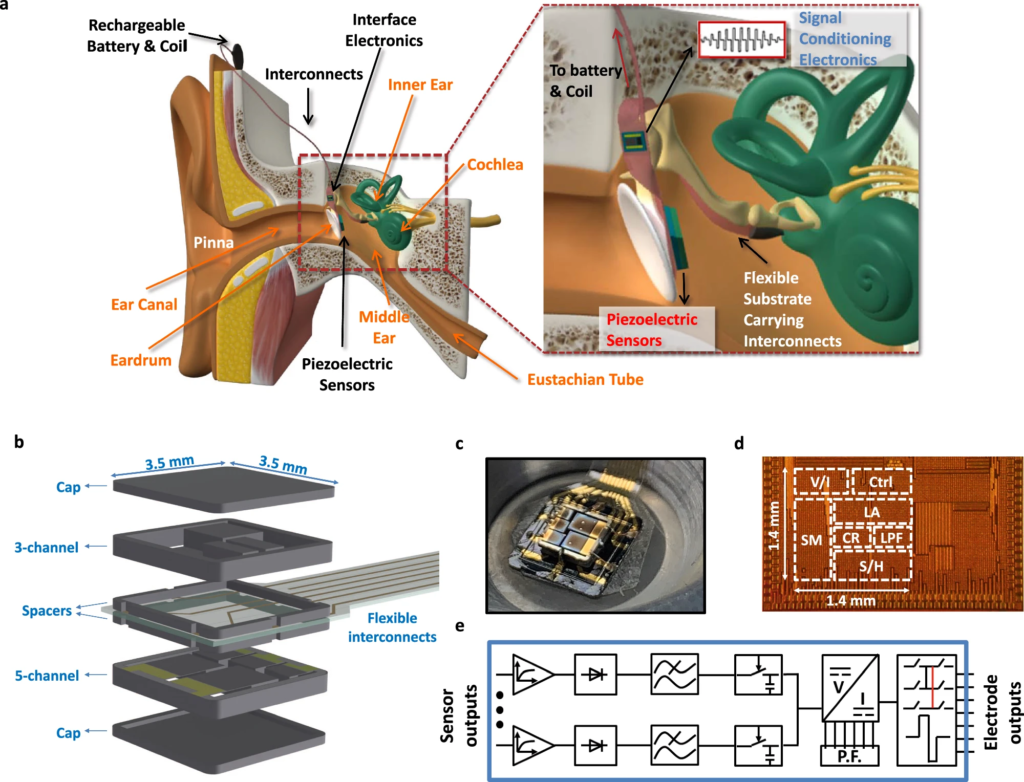In a promising breakthrough, scientists have announced a revolutionary invention: a fully integrated cochlear implant system with MEMS microphones – a complete and advanced solution that requires no external devices. For millions of people with hearing loss around the world, this is not only exciting news but also a complete change in their lives. Imagine a cochlear implant that is implanted deep in the body, operating silently and efficiently, allowing users to enjoy sound naturally without having to rely on bulky external devices. That is the future this invention is bringing.
Challenges and aspirations
Hearing loss is one of the major barriers that affect people’s quality of life. With current cochlear implant technology, users often have to deal with complex devices, including both an implanted part in the body and a part worn outside the ear to collect and process sound. Although it has significantly improved the user’s hearing ability, wearing the device outside is not only inconvenient but also affects their appearance and confidence. This is the motivation that motivated researchers to create a completely implantable solution, freeing users from the constraints of external devices.
To achieve that goal, the team faced a series of technical challenges. The first and most important question was: how to integrate all the components needed for a complete hearing system, including microphones, signal processing circuits, and electrode arrays, into a compact and durable device that operates inside the body? It was a difficult question, but also a great desire, pushing them to push the current limits of technology.
Brand new implant system with MEMS Micro
The innovative solution that the research team came up with is the MEMS microphone, or Micro-Electro-Mechanical Systems. This is a type of microphone that is extremely small, but has the ability to accurately capture and transmit sound even in complex biological environments. MEMS microphones are not a new idea, but integrating them into a fully implantable cochlear implant system is a major challenge. MEMS is a breakthrough technology that allows the creation of incredibly small microelectromechanical devices that combine mechanical and electronic components in a very limited space. When inserted into a cochlear implant system, MEMS microphones become a key element, acting as the “ears” of the device, capturing sounds from the surrounding environment and transmitting signals to the audio signal processing circuit.
In addition to the MEMS microphone, the team also developed a custom signal processing circuit that is optimized for low power consumption, which helps extend the system’s lifespan and minimize the heat generated during operation. This processing circuit must not only ensure high performance, but also process audio signals as smoothly and naturally as possible. In the human auditory system, sound is processed and decoded in a complex way to create a realistic hearing sensation. The signal processing circuit in this implant system must do the same, helping the user experience sound naturally, without being forced or distorted.
Breakthrough in electrode array design
In addition to the microphone and signal processing circuit, an important component of this implant system is the electrode array. This is the part that will directly stimulate the auditory nerve fibers in the cochlea, creating the feeling of hearing for the user. The research team designed the electrode array with high precision, helping to stimulate the nerve fibers optimally, to provide the best possible sound quality. This design requires a deep understanding of how the natural auditory system works, as well as the ability to apply the technology to complex biological environments.

Testing and promising results
To verify the system’s performance, the team conducted tests on animal models. The test results showed that the system not only operated stably but also provided amazing sound quality. The test animals responded positively to the sound, indicating that the MEMS microphone and signal processing circuit worked exactly as expected. The success of this test is a strong testament to the potential application of this implantable system in the near future.
Based on the results, the team is confident that this fully implantable system will be a major step forward in the field of hearing aids. By completely eliminating external components, the system provides a much more natural and comfortable user experience. Not having to wear an external device also reduces the psychological and social barriers for people with hearing loss, making it easier for them to integrate into everyday life.
Meaning and Importance of Research
What the team has achieved is not only a new hearing device, but also a major step forward in the field of medical technology. By integrating MEMS microphone technology and custom signal processing circuits into a fully implantable system, this research is opening up new directions for hearing implants. In the future, these devices may not only improve hearing, but also bring many other benefits to the health and quality of life of users.
However, the significance of the research extends beyond the field of hearing. The success of this implantable system also demonstrates the potential for MEMS microphones and signal processing technology to be applied to other medical devices. This could usher in a new era in which implantable medical devices will become much more compact, convenient, and effective.
Challenges and future prospects
Despite the remarkable achievements, the research still faces some challenges in the process of practical application. Clinical trials on humans will be the next step and need to be conducted carefully to ensure the safety and effectiveness of the system. In addition, another challenge is how to ensure that MEMS microphones and signal processing circuits can operate stably in biological environments for a long time without maintenance.
However, the promise of this research is huge. With the potential to completely change the approach of the hearing aid industry, this research is receiving special attention from the scientific community and medical professionals. This completely new cochlear implant system not only helps people with hearing loss to hear again, but also helps them feel confident and integrated into life.
Conclude
The fully implantable cochlear implant system with integrated MEMS microphones is a breakthrough that offers great hope to people with hearing loss. With its compact design, ability to deliver high-quality sound, and convenience without the need for external devices, it could be the ultimate solution for those looking for a more natural life, free from the constraints of traditional hearing aids.
The development of this technology is not only a technical achievement but also a symbol of the desire to improve the quality of human life. What the research team has achieved is a clear demonstration that, with creativity and endless desire, we can overcome our own limitations to bring about a better world.
Scientific report at nature Communications Engineering:
Uluşan, H., Yüksel, M.B., Topçu, Ö. et al. A full-custom fully implantable cochlear implant system validated in vivo with an animal model. Commun Eng 3, 132 (2024). https://doi.org/10.1038/s44172-024-00275-4

